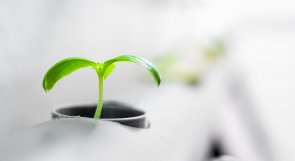
Three Terms to Know in Aquaponics
Lessons in aquaponics are not limited to textbooks and handouts – that’s the beauty of aquaponics in education. The hands-on, live, and interactive experience offered by an AquaGrove system is unmatched and creates team building opportunities and unique ways for students of all ages to become engaged and immersed in the development and maintenance of a self-sustaining “aquaponic ecosystem”.
That being stated, there are also some important lessons, processes and terminology in aquaponics that are essential to understanding the system and keeping it healthy and thriving. For this reason, we will periodically share important “terms to know” in aquaponics on our blog, to provide refreshers and conversation starters for teachers, students, and really anyone interested in cultivating a sustainable aquaponic garden.
While there are many terms, phrases, and processes that can be used to fully explain aquaponics, here are a few key words worth taking the time to review and share to better understand balancing a system:
- Beneficial Microbes – If you have ever been in a conversation regarding gardening and soil, chances are that you have heard of microbes. There are many types of microbes that reside within soil including bacteria, fungi, and viruses. And while that may sound like a combination for an illness disaster, many microbes are considered beneficial because they provide plants with an abundance of nutrients and minerals - they share a symbiotic relationship with plants. Although many people traditionally connect the idea of beneficial microbes to soil-based mediums, they actually play an important role in aquaponics systems. An aquaponics system requires beneficial bacteria for the fish and plants to thrive. Bacteria break down the fish waste, converting waste into food that the plants can absorb, providing a usable form of nutrients for the plants.
- Companion Planting – The act of companion planting is exactly as it sounds – growing different plants together, as companions. This type of planting is the cultivation of plants that not only grow simultaneously (and in the same space) but also grow harmoniously together. It is an effective way to conserve space and water while fully utilizing the grow space available. Examples of companion planting include beans which often grow well with cabbage, beets, or carrots. Another example is garlic which is often grown alongside other plants as it is a natural insect repellent. Additionally, basil (often grown in aquaponics) is widely used because it is known to enhance the flavor of vegetables as well as serve as a mosquito repellent.
- Deep Water Culture (DWC) – Deep water culture is a type of aquaponic (and hydroponic) system - AquaGrove is a DWC system. So, what does that mean? Put simply, it means that the plants’ roots are submerged in water, instead of soil. This method is also known as a raft or float system. As with AquaGrove, this method uses floating rafts to suspend plant roots into nutrient-filled and aerated water. The most basic features of a DWC system include an air pump, air stone, a net pot, and water-filled grow tank.
To learn more about aquaponics, check out some of our other blog posts and follow us on social media. To begin your own AquaGrove aquaponics garden, contact Aquagrove today
